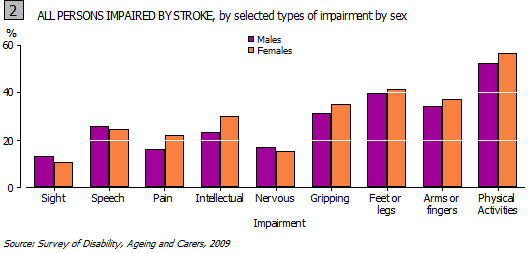This document was added or updated on 11/10/2012.
STROKE
INTRODUCTION
A stroke occurs when the blood supply to the brain is restricted, either through a blockage or bleeding. This cuts off the supply of oxygen to the brain causing damage to the affected tissue. A stroke may cause paralysis, speech impairment, loss of memory and reasoning ability, coma or death (Endnote 1).
The Survey of Disability, Ageing and Carers (SDAC) includes a number of questions to identify people in Australia who have suffered a stroke and this article presents information from this survey and other ABS collections to describe the characteristics of people who reported they have suffered a stroke.
HOW MANY AUSTRALIANS HAVE HAD A STROKE?
In 2009, an estimated 381,400 Australians (1.8% of the total population) reported they had suffered a stroke. Older people were more likely to have suffered a stroke, with 264,900 people (or 69% of people reporting having suffered a stroke) being aged 65 years or older. Males were also more likely to have reported having had a stroke, with 209,300 or 55% of people reporting having suffered a stroke, being male.

STROKE AS A CAUSE OF DEATH
'Strokes' can be categorised in a number of ways within the condition coding used in classifying causes of death (the International Classification of Diseases, Tenth Revision) including cerebral infarctions, haemorrhages and strokes not classified as infarctions or haemorrhages. As a result deaths from all forms of cerebrovascular disease are considered here as 'strokes'.
Stroke was the underlying cause of death for 11,220 people in 2010 and an associated cause for a further 20,793 people. Females are more likely to die as a result of stroke, with 59.8% of the deaths with stroke as the underlying cause being female.
HOW MANY AUSTRALIANS ARE DISABLED BY STROKES?
Of the 381,400 people who have suffered a stroke, 35% have at least one impairment as a result of that stroke which will last for six months or longer. Males were more likely to experience impairment as a result of a stroke (37%) than females (33%).
Of the people who are impaired due to their stroke, 82,800 people (62%) reported the stroke as their main disabling condition.
Graph 2 below shows that impairment in the ability to undertake physical activities was the most common impairment for people who experienced impairment as a result of a stroke. Difficulties using arms or fingers, gripping or holding things and using feet or legs were also frequently experienced problems.

IMPACT ON MULTIPLE CONDITIONS
Those people who were impaired by their stroke were likely to report more long-term health conditions than those who had a stroke but were not impaired as a consequence.

This suggests people with impairments as a consequence of a stroke have more complex needs than those who did not suffer impairments associated with their stroke, a factor that will be important in managing their health and care needs.
ENDNOTES
1.
Farlex Inc., The Free Dictionary, Stroke, 2012, viewed 29 August 2012, <
http://www.medical-dictionary.thefreedictionary.com/stroke>
 Print Page
Print Page
 Print All
Print All